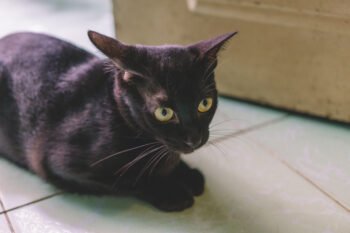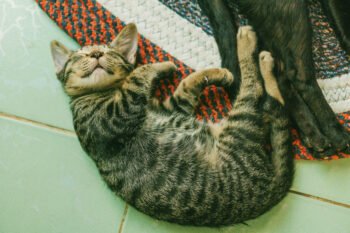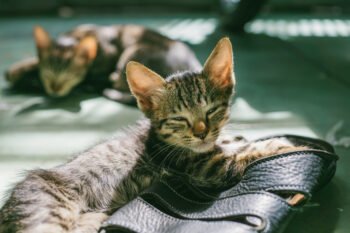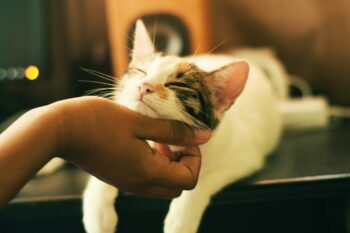Learn the ABCs of your cat’s health with our guide to feline health terminology. You’ll be impressing your vet in no time. Click on any letter below to jump down to definitions of terms beginning with that letter.
— A —
Allogrooming: Licking or grooming of others in the social group or species.
Asthma, Feline: This disease is an immune-mediated disease characterized by symptoms ranging from infrequent, hairball-like coughing, to sudden onsets of respiratory distress (which veterinarians call "acute dyspnea"). Episodesare usually triggered by an allergen or stress, and can be accompanied/followed by vomiting, sneezing, or even wheezing like a human allergy sufferer. Respiratory signs may be slow and deliberate (more abdominal breathing), to fast and labored.
Long-term treatment of asthma usually includes short or long-term use of corticosteroids (such as prednisone), and bronchodilators (such as terbutaline or aminophyline). While severe "episodes" of dyspnea can occur, the long-termprognosis of this disease is generally excellent. If diagnosed early, any structural changes to the lungs and airway are usually reversible, and damage can minimized.
— B —
Barbering: excessive hair-biting
Bladder Stones & Urinary Obstructions: A urolith is stone-like object that can be found in the bladder and, less commonly, in the kidney, of cats. Some studies have shown that up to 13% of cats with lower urinary tract disease today have uroliths. They can be present without causing any symptoms in the cat, but they are very often associated with hematuria (blood in the urine), pollakuria (increased frequency of urination) and dysuria (difficulty passing urine). Many cats will attempt to urinate outside of their litterbox. In some cases, uroliths can cause partial or total obstruction of the urethra (the tube leading from the bladder outside the body), so that little or no urine can pass.
Obstructions are often emergency situations for the cat, causing great pain and endangering its life. Owners may see their cat visiting the litterbox frequently and straining and erroneously believe the cat is constipated. Cats can have several types of uroliths, but the two most common types are struvite (magnesium ammonium phosphate or MAP) and calcium oxalate. In the past, the most common urolith type was struvite. However, in the last ten years, the number of calcium oxalate uroliths has increased so that now the two types occur with almost equal frequency. This is suspected to be due to changes in feline diet formulations, for the acidic diets that discourage struvite uroliths can actually encourage calcium oxalate uroliths to form in some cats.
— C —
Calicivirus, Feline: This disease is caused by a virus and may cause the following clinical signs: lethargy, loss of appetite, sneezing, conjunctivitis, and ulceration of the hard palate and tongue. Some strains of the virus may produce a "limping syndrome," especially in kittens.
Complusive Disorder: recurrent obsessions or compulsions that are severe enough to be time-consuming or cause marked distress or significant impairment; as in dogs and other animals, the equivalent of human obsessive-compulsive disorder in cats is termed compulsive disorder or CD.
Constipation: Occasional constipation in aging cats is not unusual, but if it persists, consult your veterinarian. Prolonged constipation could be a sign of something more serious.
— D —
Diabetes, Feline: Diabetes Mellitus ("sugar" diabetes) is a fairly common disease seen in the cat. There are two types: Insulin Dependent (IDDM), comprising about 50-70% of cats, and non-Insulin Dependent (NIDDM), about 30-50% of cats. While NIDDM is usually caused by obesity, and is reversible, IDDM can be caused by a verity of factors, including pancreatic islet amyloidosis, obesity, infection, concurrent illness, certain drugs (such as cortisone), pancreatitis, genetic predisposition, and immune-medicated insulitis. Pancreatitis, islet amyloidosis, and renal insufficiency secondary to diabetes have recently been strongly implicated in association with both forms of diabetes.
Many cats have transient diabetes, in which insulin requirements disappear completely. Both types cause the cat to develop "hyperglycemia," unusually high blood sugar levels. The classic signs of diabetes are an obese cat with excessive thirst {polydipsia}, excessive urination {polyuria}, and a ravenous appetite combined with weight loss. Some cats may develop a plantigrade posture, where the hocks touch the ground when they walk. The additional signs of loss of appetite, weakness, vomiting, dehydration, and occasionally a strong odor of acetone on the breath which may indicate a dangerous state in a diabetic called ketoacidosis. Diagnosis of ketoacidosis is usually made upon measuring large amounts of ketones in the cats urine. This condition is fatal if not treated promptly.
Initial treatment for a diabetic animal requires 24-48 hours of hospitalization for glucose during initial insulin administration. Then, weekly 12-14 hour "glucose curves" are required to evaluate patient response, lasting 4-6 weeks. Periodic glucose levels need to be monitored, how often depending on how well the patient is responding.
In general, diabetes mellitus carries a guarded long term diagnosis in cats, with an average survival time between 18-24 months, all depending on the age of onset, and concurrent illness. However, with proper veterinary care by owners, timely evaluations by your vet, and good owner-veterinarian communication, many diabetic cats can live relatively normal lives for several years.
Diarrhea: Diarrhea in cats may be caused by an abrupt change in diet, internal parasites (worms), foreign body ingestion or a more serious illness, including those already discussed. Consult your veterinarian if the diarrhea persists for more than 24 hours. When you visit the veterinarian, a fresh stool sample may aid in the diagnosis of internal parasites.
— E —
Ear Mites: These external parasites invade the ear and cause itchiness, redness and in some cases, severe infection. Although you cannot see the individual mites in the ear, you may see a dark discharge in your cat’s ear. See your veterinarian for the appropriate diagnosis and treatment.
Euthanasia: the practice of humanely ending the life of a beloved pet
Eye & Ear Disorders: Eye discoloration in senior cats is often a normal part of the aging process. Usually it does not interfere with vision and does not need treatment. Some cats develop cataracts, but they are relatively uncommon. If your pet’s eyes become red and watery, the problem could be conjunctivitis. If this condition persists, consult your veterinarian. Seeing and hearing may diminish with age — one more reason you should not allow your cat to roam out-doors. At home, be patient if he doesn’t always respond to your call, and don’t frighten him by suddenly coming up behind him unannounced.
— F —
Feline Asthma: This disease is an immune-mediated disease characterized by symptoms ranging from infrequent, hairball-like coughing, to sudden onsets of respiratory distress (which veterinarians call "acute dyspnea"). Episodesare usually triggered by an allergen or stress, and can be accompanied/followed by vomiting, sneezing, or even wheezing like a human allergy sufferer. Respiratory signs may be slow and deliberate (more abdominal breathing), to fast and labored.
Long-term treatment of asthma usually includes short or long-term use of corticosteroids (such as prednisone), and bronchodilators (such as terbutaline or aminophyline). While severe "episodes" of dyspnea can occur, the long-termprognosis of this disease is generally excellent. If diagnosed early, any structural changes to the lungs and airway are usually reversible, and damage can minimized.
Feline Calicivirus: This disease is caused by a virus and may cause the following clinical signs: lethargy, loss of appetite, sneezing, conjunctivitis, and ulceration of the hard palate and tongue. Some strains of the virus may produce a "limping syndrome," especially in kittens.
Feline Diabetes: See Diabetes, Feline.
Feline Hyperesthesia: literally "exaggerated sensation," is a poorly understood and disturbing problem in which cats sporadically and suddenly growl, caterwaul and leap through the air.
Feline Hyperthyroidism: Hyperthyroidism (also called thyrotoxicosis) is one of the most common diseases of the middle-aged and older cat. It is a multi-system disorder caused by an increase in the amount of thyroid hormones (T3 and T4) produced by an enlarged thyroid gland. It was first documented in cats almost 30 years ago but the cause of the disease has been elusive. Although the enlargement in the thyroid gland is caused by a tumour, called an adenoma, it is non-cancerous.
The most common clinical signs of hyperthyroidism in cats include weight loss, increased appetite (although some patients have decreased appetite), vomiting, increased thirst and urination, hyperactivity, and diarrhea. The high levels of thyroid hormones can cause the development of heart disease, and these patients may have a heart murmur, difficulty breathing, high heart rate and arrhythmias. Once hyperthyroidism has been confirmed, there are several treatment options. They include treatment with radioactive iodine, surgical removal of the gland, and treatment with antithyroid medications.
Feline Immunodeficiency Virus: This relatively new viral disease affects the immune systems of cats. Cats that are infected with the virus may have the following clinical signs: gingivitis, anorexia, lethargy, fever, chronic upper respiratory disease, chronic conjunctivitis, and chronic skin infections.
Feline Infectious Peritonitis: This viral disease causes the following clinical signs: fever, lethargy, conjunctivitis, loss of appetite, diarrhea, ascites (fluid in the abdomen), pleural effusion (fluid in the chest). The virus may also cause neurological signs.
Feline Leukemia: Cats infected by this serious disease often have the following clinical signs: lethargy, loss of appetite, weight loss, pale mucous membranes, and labored breathing.
Feline Lower Urinary Tract Disease (FLUTD): FLUTD (also referred to as F.U.S. –Feline Urological Syndrome) is one of the major health concerns of cat owners. Since this disease affects both male and female cats, it is a disease about which every cat owner should be informed. Feline Lower Urinary Tract Disease is a condition associated with the lower urinary tract. Most frequently, this involves the symptoms specifically associated with the cat’s urinary bladder. Some of the symptoms may include: straining in the litter box, crying while trying to urinate, frequent urination, and blood in the urine. If left untreated, the result can be a complete blockage of the urethra (the tube leading from the bladder to the outside).
Blockage occurs more commonly in male cats because the urethra tends to be narrower than in the female. If your cat exhibits any of these symptoms, have him examined by your veterinarian immediately. FLUTD occurs most commonly in young adult cats between one and six years old. Cats prone to developing FLUTD usually experience their first episode by the age of three.
Feline Oral Resorptive Lesion (FORL): A common feline oral malady which affects a majority of cats older than four years. These tooth defects have also been called cavities, neck lesions, external or internal root resorptions, and cervical line erosions. The location of FORL is usually at the labial or buccal surface of the cemento-enamel junction (CEJ) where the free gingiva meets the tooth surface. The most common teeth affected are the maxillary third and fourth premolars and the lower third premolar and first molars, however FORLs can be found on any tooth. The etiology is unknown, however theories supporting an autoimmune response mediating cellular and humoral factors, calici virus, and metabolic imbalances relating to calcium regulation have been proposed.
Feline Panleukopenia: This viral disease is especially dangerous, and is often fatal to kittens. The most common signs of this disease are depression, loss of appetite, fever, dehydration, vomiting and diarrhea.
Feline Pneumonitis: This disease is caused by an organism called Chlamydia psittici. The clinical signs are similar to those of rhinotracheitis, but often less severe. Infection with this organism may produce conjunctivitis and mild sneezing.
Feline Viral Rhinotracheitis: This viral disease may cause the following clinical signs: Fever, lethargy, sneezing, abnormal discharge from the eyes or nose, and loss of appetite. More severe cases may have mouth and eye ulcers.
Fleas: These external parasites can be pests for you and your cat. Many cats are allergic to flea saliva, which causes an intense pruritis (itch) and secondary bacterial infection. This is called flea allergy dermatitis. Fleas are also capable of transmitting tapeworms to cats. Fleas on the cat can be controlled with various flea prevention products. Be sure to use products that are safe for your cat, and consult your veterinarian for proper flea control.
Flehmen: an open-mouth behavior which accompanies sniffing, especially in sexually intact tom cats
— H —
Heart Trouble: Though not common, heart disease can strike the geriatric cat. Lack of energy, not wanting to move or be moved, coughing, and labored breathing are all possible clues. Prompt medical attention is required. Your veterinarian will outline the proper treatment protocol for your cat.
Hip Dysplasia, Feline: Hip dysplasia is a disease of the hip joint. "Dysplasia" is a word that means abnormal development of a tissue. The hip is a ball and socket type of joint. The "ball" is the top of the femur (called the "head") which fits into the acetabulum. A normal joint has a close fit of the femur’s head into the acetabulum, so that the joint functions smoothly and efficiently. The large muscles of the hip and pelvis help hold the joint in place and allow it to function properly. In hip dysplasia , parts of the hip joint are abnormally shaped, so that the fit of the ball into the socket is poor. This allows the head of the femur to move easily out of the joint to some degree (called "subluxation" = dislocation). Over time, chronic changes develop in the bones of the hip joint from this abnormal movement and degeneration joint disease may result. In most cases, both hip joints are affected although one may be more severe than the other. Many cats with hip dysplasia go undetected.
Due to their small size and the fact that cats are not exercised as much as dogs, along with their natural agility, they may have hip dysplasia and still function normally. In some cats, hip dysplasia is found incidentally when they are x-rayed for another reason. This disease is not obvious at birth, but develops as the young kitten grows. If a cat is known to have dysplastic hips and is overweight, weight reduction will reduce the chances that discomfort will be experienced.
For cats who are diagnosed with hip dysplasia because they developed clinical signs of lameness and pain, several treatments are available. Veterinarians use anti-inflammatory and pain medications as well as dietary supplements designed to help in joint repair. Restricting exercise, such as limiting access to outdoors or the ability to climb up on objects, can be helpful as well. For severely affected cats, a surgery called a femoral head and neck excision arthroplasty is widely available that removes the damaged tissue. Cats who have had this surgery can usually expect a full return of hip function and freedom from pain and discomfort once post-operative healing has occurred.
Hyperthyroidism, Feline: Hyperthyroidism (also called thyrotoxicosis) is one of the most common diseases of the middle-aged and older cat. It is a multi-system disorder caused by an increase in the amount of thyroid hormones (T3 and T4) produced by an enlarged thyroid gland. It was first documented in cats almost 30 years ago but the cause of the disease has been elusive. Although the enlargement in the thyroid gland is caused by a tumour, called an adenoma, it is non-cancerous.
The most common clinical signs of hyperthyroidism in cats include weight loss, increased appetite (although some patients have decreased appetite), vomiting, increased thirst and urination, hyperactivity, and diarrhea. The high levels of thyroid hormones can cause the development of heart disease, and these patients may have a heart murmur, difficulty breathing, high heart rate and arrhythmias. Once hyperthyroidism has been confirmed, there are several treatment options. They include treatment with radioactive iodine, surgical removal of the gland, and treatment with antithyroid medications.
— I —
Immunodeficiency Virus, Feline: This relatively new viral disease affects the immune systems of cats. Cats that are infected with the virus may have the following clinical signs: gingivitis, anorexia, lethargy, fever, chronic upper respiratory disease, chronic conjunctivitis, and chronic skin infections.
Infectious Peritonitis, Feline: This viral disease causes the following clinical signs: fever, lethargy, conjunctivitis, loss of appetite, diarrhea, ascites (fluid in the abdomen), pleural effusion (fluid in the chest). The virus may also cause neurological signs.
Inflammatory Bowel Disease: IBD is actually a group of gastrointestinal disorders, usually chronic in nature, which are characterized by an increase in the number of inflammatory cells found in the lining of the stomach or intestinal tract. These changes can affect the function of the organ involved. The causes of IBD are variable, and often no single cause can be identified in a given patient. The symptoms include chronic vomiting, diarrhea, or both, and in some cases, weight loss and change in appetite. Some patients may defecate outside their litterbox, especially if diarrhea is present. The symptoms may be cyclical in nature, with the cat appearing to be normal at times.
It is not unusual for these patients to be misdiagnosed as having hairballs. A definitive diagnosis of IBD is only possible by intestinal biopsy, which is best accomplished using fibreoptic endoscopy. This technology allows veterinarians to diagnose and treat many gastrointestinal disorders more easily than in the past. Once diagnosed, the disease can be controlled to prevent pain and discomfort to the cat. Treatment is also aimed at preventing possible complications of the disease, such as damage to the liver, malnutrition, ulcers, and in some cases, the future development of cancer. Many medications can be used to control IBD. These include prednisone (the treatment of choice in many cases), some antibiotics, and antiemetics (drugs that suppress vomiting). Once therapy is started, it is usually continued for 2 to 3 months, before attempts are made to decrease the amount of medication. In many cases, a hypoallergenic diet may be recommended to aid in control of the disease.
— K —
Kidney Disease: If your cat begins to drink excessively and urinate frequently, he might be suffering from kidney disease, a common disorder among older cats. There may even be occasional accidents outside the litter box. If this happens, don’t label your pet senile or naughty — he may be under extreme pressure and unable to hold his urine. Make sure that a litter box is accessible at all times, and keep it clean. Cats are impeccable by nature. See to it that your cats get the water that he needs. Report any symptoms to your veterinarian.
— L —
Leukemia, Feline: Cats infected by this serious disease often have the following clinical signs: lethargy, loss of appetite, weight loss, pale mucous membranes, and labored breathing.
— M —
Mites, Ear: These external parasites invade the ear and cause itchiness, redness and in some cases, severe infection. Although you cannot see the individual mites in the ear, you may see a dark discharge in your cat’s ear. See your veterinarian for the appropriate diagnosis and treatment.
— P —
Panleukopenia, Feline: This viral disease is especially dangerous, and is often fatal to kittens. The most common signs of this disease are depression, loss of appetite, fever, dehydration, vomiting and diarrhea.
Piloerection: when cat’s hair stands on end in response to a threatening situation
Pneumonitis, Feline: This disease is caused by an organism called Chlamydia psittici. The clinical signs are similar to those of rhinotracheitis, but often less severe. Infection with this organism may produce conjunctivitis and mild sneezing.
Polycystic Kidney Disease: This disease is an inherited kidney disease that has been found in Persian cats. Polycystic disease is a disease that shows up later in life (late onset) with enlarged kidneys and kidney dysfunction occurring between three and 10 years of age (on average at seven years of age). The condition is inherited and cysts are present from birth, but are smaller in younger animals. Cyst size can vary from less than 1 mm to greater than 1 cm in size, with older animals having larger and more numerous cysts. Problems occur when these cysts start to grow and progressively enlarge the kidney, reducing the kidney’s ability to function properly. The ultimate end is kidney failure.
Some of the clinical signs are depression, lack of or reduced appetite, excessive thirst, excessive urination and weight loss. There is a marked difference in when and how quickly individual cats succumb, with the possibility of this developing late enough in life that the cat can die of other causes before kidney failure. However, kidney failure is certain when the cysts can grow and cause problems. Rarely, cysts are also seen in other organs such as the liver and uterus. PKD is most easily diagnosed by ultrasound. Ultrasound is a non-invasive imaging technique that can identify the disease very early in its course.
There is no specific treatment for this disease. Treatment is similar to treatment of chronic kidney failure of any cause. This treatment includes moderate dietary protein restriction using high biological value protein, dietary phosphorus restriction, providing fresh drinking water at all times, use of phosphate binders, and treatment of the anemia if necessary.
Psychogenic Alopecia: hair loss due to psychological, or behavioral, reasons. Psychogenic alopecia may occur spontaneously or may be associated with anxiety.
— R —
Rabies: This disease is caused by a virus found in the saliva of infected animals and is transmitted to pets and humans by bites, or possibly by contamination of an open cut. Treatment of an infected person is critical. Untreated, rabies causes a painful death. Most animals can be infected by the virus and can transmit the disease to man. Infected bats, raccoons, foxes, skunks, dogs or cats provide the greatest risk to humans. Have your pets vaccinated against rabies. Any pets that come in contact with wild animals are at risk. Many local health departments conduct public vaccination clinics for dogs and cats. Your veterinarian can also vaccinate your pet against rabies.
During recent years, confirmed cases of rabies in cats have exceeded the reported cases in dogs in some parts of the United States making vaccination and booster shots critical to your health and that of your pets. If your cat or dog has been bitten or attacked by a wild animal or has bites or scratches of unknown origin, call your local health department or animal control officer to report the incident. If your cat or dog has bitten a person, call your local health department or animal control officer to report the incident.
— T —
Teeth & Gum Disease: It is important to care for the health of your cat’s teeth and gums, starting when he is young. Tartar build-up and enamel erosion are the main causes of serious gum disease. Your veterinarian can show you how to brush your cat’s teeth. It’s the most effective way to control tartar buildup. A finger brush, pet toothbrush or child’s soft toothbrush along with pet toothpaste is the best combination. Your cat will need regular teeth cleaning by your veterinarian, especially when he gets older. If your cat begins to favor one side of his mouth, or if he suddenly stops eating as if his mouth is sore, have your veterinarian take a look.
Trichobezoars: Hairballs
Tumors: Tumors can occur in nearly any part of the cat’s body, but you should pay special attention to persistent swelling or inflammation in mammary glands, particularly in unspayed females. Early detection and treatment give your cat the best chance to survive tumors or cancer.
— V —
Viral Rhinotracheitis, Feline: This viral disease may cause the following clinical signs: Fever, lethargy, sneezing, abnormal discharge from the eyes or nose, and loss of appetite. More severe cases may have mouth and eye ulcers.
Vomiting / Regurgitation: Vomiting, characterized by expulsion of bile and / or digested food, is indicative of a problem and should be reported to your veterinarian. Regurgitation, characterized by expulsion of tubular, bile-free undigested food, is often caused by hairball obstruction. While this may not be indicative of a serious illness with your cat, you should consult your veterinarian if this problem persists.







